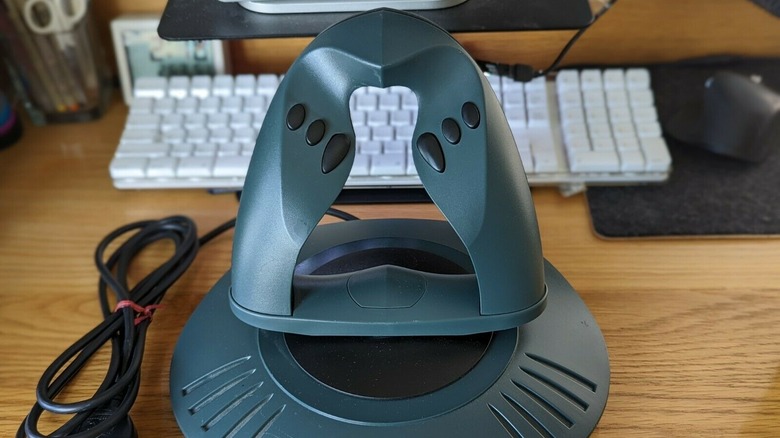The 1998 Game Controller That Tried To Replace Your Mouse
ThrustMaster (TM) has been kicking out video game controllers since 1990. Whether you're a hardcore flight simmer or just a weekend space jockey zipping around the galaxy fragging TIE Fighters, a hands-on throttle-and-stick from TM is the kit you want on your desk. It also makes some crazy good, and expensive, racing wheels that usually take the checkered flag in most "best of" lists.
While en route to becoming one of the best in the biz, though, the mighty peripheral maker has dropped a few clunkers along the way, none more clunky than ... the FragMaster.
So let's get behind the wheel of our DeLorean time machine, hit 88 mph, and jump back to 1998, a year awed by all things "Titanic." We also saw Ginger Spice (Geri Halliwell) leave the Spice Girls mid-tour, got introduced to Viagra's little blue pill, and watched as "Seinfeld's" nine-year "show about nothing" ended up behind bars. And we all got our first glimpse of Jar Jar Binks in the first trailer for "Star Wars: Episode I: The Phantom Menace."
It was also the year ThrustMaster released a wacky device for a retail price of $70, meant to replace the mouse and keyboard so first-person shooter (FPS) fans could frag their way to glory.
In a form that looked more like a television antenna than a gaming device, the two-handed FragMaster controller came with comfortable ergonomic grips that allowed gamers to play Quake, Duke Nukem 3D, Unreal, and other FPS' games for an extended period. The jargon on the box even said, "You won't need cheat codes with one of these."
Frag like it's... 1998?
The horseshoe-shaped controller was equipped with four short throw secondary buttons, two large contact thumb buttons, and four wrap-around triggers on the back, all of which could be programmed to replicate keyboard and mouse functions, like crouch, fire, jump, etc. It was all set atop a base with four-axis movement.
Players were supposed to move the grips in whichever direction they wanted to dodge incoming rockets. Additionally, circle strafing was all the rage back then, and ThrustMaster implied that you could turn the grips like you were moving around in real life. It appears ThrustMaster was attempting to provide a very early version of virtual reality hand controllers.
The "M" (mouse) Look feature was meant to mimic using a mouse to look around. Pushing the controller down made you look down; pulling back on it made you look up, and side to side replicated turning your head in that direction. It was supposed to help gamers take out unwanted campers with ease. But the pièce de résistance was the highly touted MegaHurts Mode, which was supposed to emulate a mouse's quick response movement and accuracy.
In reality, none of this worked entirely as well as intended. In one of the few hands-on reviews still left on the Internet, moving the clunky controller around "was very uncomfortable" and "aiming was also difficult." Also, because the hand grips were "set at a downward angle," trying to aim up was uncomfortable and moved the entire base around. Another review from 2014 made similar statements about its agonizing "ergonomic design."
While getting the most frags is undoubtedly the name of the game, using the FragMaster to get them most certainly wasn't the way.
